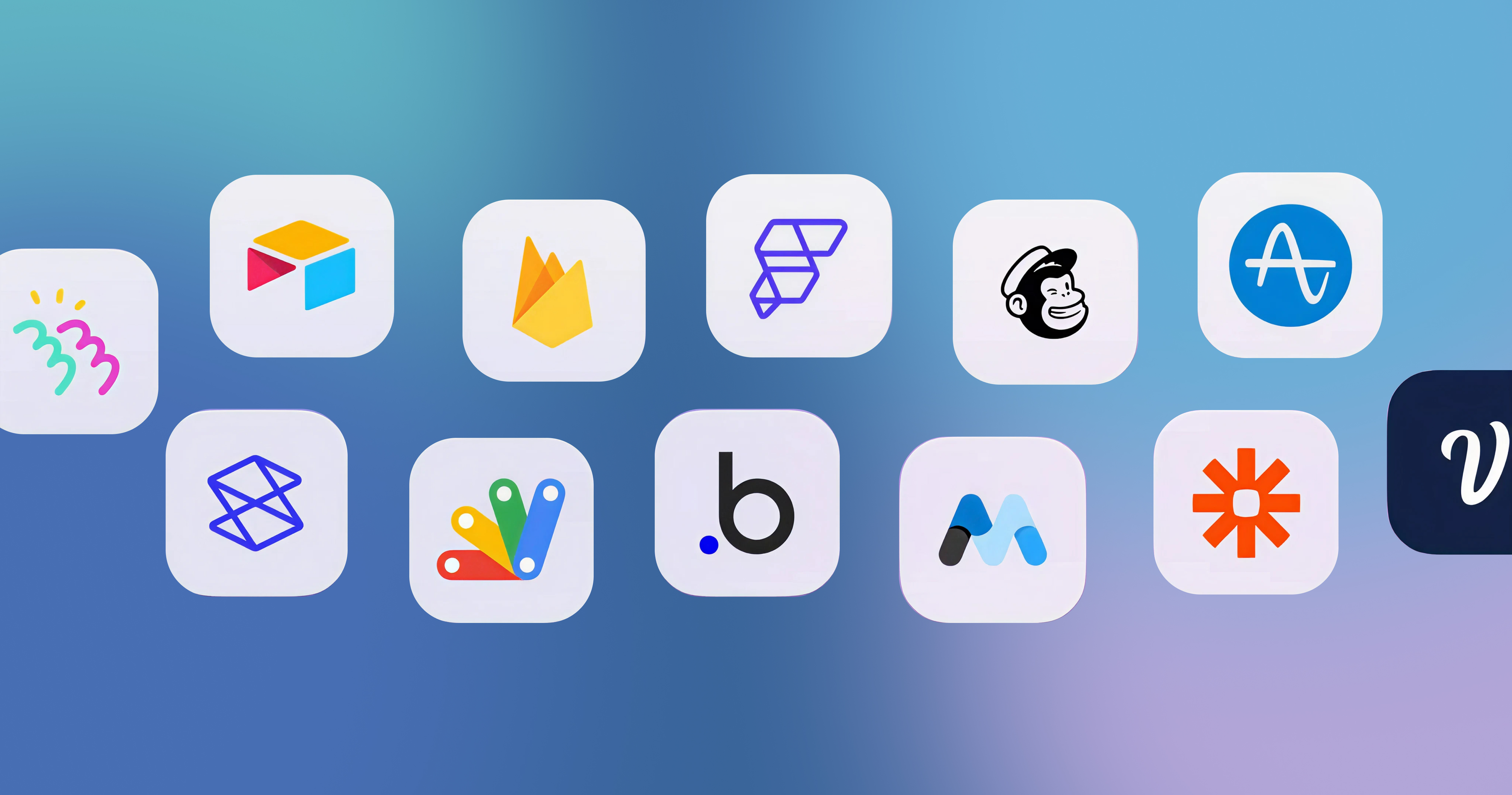-p-2000.png)


Building Ophelia: Nelson's guide to crafting a no-code marketplace

The skill set required for building a website has drastically changed over the years. From all-code to no-code, times have really changed.
Using a no-code or a low-code platform to build your website is definitely easier than lots of coding. It’ll take a while to figure out the logic, the flow and the stack you need to build it on.
This how-to article is based on a video made by a renowned Webflow expert, Nelson Abalos Jr. We will track and document some of the actions he took during the launch of his new service website HiOphelia.com.
Ophelia provides a platform where members can discover and request the services of registered web developers (Pros). If you want to know more, don’t hesitate and check it out yourself (hiophelia.com).
Building a marketplace requires more attention and time when compared to building a basic website. This guide focuses on how to build a marketplace with just no-code tools. Yep! If you are code-averse this one's for you.
Disclaimer: This guide is based on Nelson’s launch video. We’ve just mixed in a tinge of our personality.
Building your MVP
You know that feeling when you get this idea and keep building it until it becomes a super elaborate idea?
It feels great! But it’s always good to start small. The last thing you want is to get overwhelmed by your own idea. This is why a minimum viable product (MVP) should be your first step.
An MVP can perform all many of the basic and essential functions of your website or application.

Nelson built Ophelia for two types of users: Members (users who create tickets) and Pros (users who resolve tickets). His MVP had a total of four main functions, two for each type of users:
- Members: Converting money to credits and creating tickets
- Pros: Gaining credits on solving tickets and cashing out credits
By establishing clear objectives, you can decide on your stack, flow and logic without completely committing to an MVP model. If something doesn't work out, you can easily switch and add tools till your MVP functions as it should.
The stack - WAMMS
Building a membership portal with e-commerce functionality requires multiple no-code solutions.
You’ll need a CMS (Content Management System) to handle the base website, a membership platform to handle user account creation and management, a database system, a payment processing platform and of course, an automation tool to keep all these platforms connected.
For Ophelia, Nelson opted for the WAMMS (Webflow-Airtable-Memberstack-Make-Stripe) stack, which consists of only no-code and low-code tools. The best part about this stack is that they are relatively easier to use when compared to pro-code tools. You might even get away without using any code on some of these platforms.

CMS - Webflow
For the CMS, Nelson chose Webflow (naturally!). Webflow is a powerful web design and development platform that enables users to create professional websites and web applications without coding. With its hosting and CMS capabilities, Webflow provides a complete solution for building and managing websites.
For more insights on the advantages of using Webflow, check out our article on Top 15 Reasons to Use Webflow
Payment - Stripe
Stripe is one of the popular choices when it comes to payment processing platforms. Stripe ensures that the transactions stay secure and supports various payment methods. This makes it a great choice for e-commerce businesses and startups looking for reliable and flexible payment solutions. By integrating Stripe with Webflow, you can open a door to a lot of possibilities.
Membership - Memberstack
In order to realize a user account system on Webflow, you’ll have to use a memberships platform. For Ophelia, Nelson opted for Memberstack with his alternate options being Webflow Memberships and Outsetta.
Memberstack is a user-friendly platform that allows website creators to implement a membership and subscription functionality to their websites. You can create membership plans and utilize access roles to create gated content.
Data storage - Airtable
With the user account and membership parts now sorted, we need to figure out where to store all the data. After evaluating Webflow collections and Memberstack, Nelson settles down on his third option - Airtable.
Airtable is a collaborative, cloud-based spreadsheet and database management platform that allows users to organize and manage information, tasks, and more. To know more about Airtable, check out our article on What is Airtable & How Does It Work? (+ Use Cases)
Automation platform - Make
Now that you’ve decided on all the tools which act as sources and gateways, it’s time to connect them all together!
For automation, Nelson explores Webflow Logic, Zapier and finally, Make. Make.com used to be Integromat. Make is their rebrand.
While Make does get the deed done, Nelson does talk about implementing Wized into the Stack.
Wized offers more freedom and customization capability but it demands a certain level of coding skills and more importantly, time. Nelson mentions that he intends to eventually swap Make with Wized when the time is right.
Potential of WAMMS

Using the WAMMS stack is a great choice for implementing MVPs involving user accounts, memberships and payment.
In fact, we’ve used the same stack for some of our projects. The requirements for these projects aren’t always the same. In some cases, the price of a product might vary based on user membership or there might be validation processes involved for user account creation. It’s quite difficult to identify when and where a certain stack would fit in.
Even after you’ve identified your tool kit, it’s not exactly easy to build an entire model without the proper knowledge and guidance.
Wrapping up!
While the WAMMS stack can provide a robust solution, it doesn’t have to be the answer for every scenario. Your stack will definitely depend on the complexity of your requirements.
Nelson wanted to share his experience and knowledge hoping that others would benefit from it. In fact, Ophelia is aimed to help Members connect with the right Pros to realize their projects. It’s just like how Nelson describes it - 'Help your fellow human in a positive way'
We wish Nelson and Ophelia the best in their new endeavor!
With that said, building a marketplace doesn't have to be a complex, time-consuming, or expensive process. Our no-code agency specializes in helping businesses like yours create powerful marketplaces quickly and cost-effectively.
We have a proven record of successful partnerships and a team of experts ready to assist. Contact us today and together, we will transform your idea into a marketplace that connects users, boosts revenue, and moves your business forward.

FAQ
Editorial Team
Publisher
The skill set required for building a website has drastically changed over the years. From all-code to no-code, times have really changed.
Using a no-code or a low-code platform to build your website is definitely easier than lots of coding. It’ll take a while to figure out the logic, the flow and the stack you need to build it on.
This how-to article is based on a video made by a renowned Webflow expert, Nelson Abalos Jr. We will track and document some of the actions he took during the launch of his new service website HiOphelia.com.
Ophelia provides a platform where members can discover and request the services of registered web developers (Pros). If you want to know more, don’t hesitate and check it out yourself (hiophelia.com).
Building a marketplace requires more attention and time when compared to building a basic website. This guide focuses on how to build a marketplace with just no-code tools. Yep! If you are code-averse this one's for you.
Disclaimer: This guide is based on Nelson’s launch video. We’ve just mixed in a tinge of our personality.
Building your MVP
You know that feeling when you get this idea and keep building it until it becomes a super elaborate idea?
It feels great! But it’s always good to start small. The last thing you want is to get overwhelmed by your own idea. This is why a minimum viable product (MVP) should be your first step.
An MVP can perform all many of the basic and essential functions of your website or application.

Nelson built Ophelia for two types of users: Members (users who create tickets) and Pros (users who resolve tickets). His MVP had a total of four main functions, two for each type of users:
- Members: Converting money to credits and creating tickets
- Pros: Gaining credits on solving tickets and cashing out credits
By establishing clear objectives, you can decide on your stack, flow and logic without completely committing to an MVP model. If something doesn't work out, you can easily switch and add tools till your MVP functions as it should.
The stack - WAMMS
Building a membership portal with e-commerce functionality requires multiple no-code solutions.
You’ll need a CMS (Content Management System) to handle the base website, a membership platform to handle user account creation and management, a database system, a payment processing platform and of course, an automation tool to keep all these platforms connected.
For Ophelia, Nelson opted for the WAMMS (Webflow-Airtable-Memberstack-Make-Stripe) stack, which consists of only no-code and low-code tools. The best part about this stack is that they are relatively easier to use when compared to pro-code tools. You might even get away without using any code on some of these platforms.

CMS - Webflow
For the CMS, Nelson chose Webflow (naturally!). Webflow is a powerful web design and development platform that enables users to create professional websites and web applications without coding. With its hosting and CMS capabilities, Webflow provides a complete solution for building and managing websites.
For more insights on the advantages of using Webflow, check out our article on Top 15 Reasons to Use Webflow
Payment - Stripe
Stripe is one of the popular choices when it comes to payment processing platforms. Stripe ensures that the transactions stay secure and supports various payment methods. This makes it a great choice for e-commerce businesses and startups looking for reliable and flexible payment solutions. By integrating Stripe with Webflow, you can open a door to a lot of possibilities.
Membership - Memberstack
In order to realize a user account system on Webflow, you’ll have to use a memberships platform. For Ophelia, Nelson opted for Memberstack with his alternate options being Webflow Memberships and Outsetta.
Memberstack is a user-friendly platform that allows website creators to implement a membership and subscription functionality to their websites. You can create membership plans and utilize access roles to create gated content.
Data storage - Airtable
With the user account and membership parts now sorted, we need to figure out where to store all the data. After evaluating Webflow collections and Memberstack, Nelson settles down on his third option - Airtable.
Airtable is a collaborative, cloud-based spreadsheet and database management platform that allows users to organize and manage information, tasks, and more. To know more about Airtable, check out our article on What is Airtable & How Does It Work? (+ Use Cases)
Automation platform - Make
Now that you’ve decided on all the tools which act as sources and gateways, it’s time to connect them all together!
For automation, Nelson explores Webflow Logic, Zapier and finally, Make. Make.com used to be Integromat. Make is their rebrand.
While Make does get the deed done, Nelson does talk about implementing Wized into the Stack.
Wized offers more freedom and customization capability but it demands a certain level of coding skills and more importantly, time. Nelson mentions that he intends to eventually swap Make with Wized when the time is right.
Potential of WAMMS

Using the WAMMS stack is a great choice for implementing MVPs involving user accounts, memberships and payment.
In fact, we’ve used the same stack for some of our projects. The requirements for these projects aren’t always the same. In some cases, the price of a product might vary based on user membership or there might be validation processes involved for user account creation. It’s quite difficult to identify when and where a certain stack would fit in.
Even after you’ve identified your tool kit, it’s not exactly easy to build an entire model without the proper knowledge and guidance.
Wrapping up!
While the WAMMS stack can provide a robust solution, it doesn’t have to be the answer for every scenario. Your stack will definitely depend on the complexity of your requirements.
Nelson wanted to share his experience and knowledge hoping that others would benefit from it. In fact, Ophelia is aimed to help Members connect with the right Pros to realize their projects. It’s just like how Nelson describes it - 'Help your fellow human in a positive way'
We wish Nelson and Ophelia the best in their new endeavor!
With that said, building a marketplace doesn't have to be a complex, time-consuming, or expensive process. Our no-code agency specializes in helping businesses like yours create powerful marketplaces quickly and cost-effectively.
We have a proven record of successful partnerships and a team of experts ready to assist. Contact us today and together, we will transform your idea into a marketplace that connects users, boosts revenue, and moves your business forward.
FAQ
Editorial Team
Publisher




Hi, I'm Mike!
If you are enjoying the article, feel free to subscribe to our monthly newsletter.
If you have any project requirements, please contact us.






.png)










